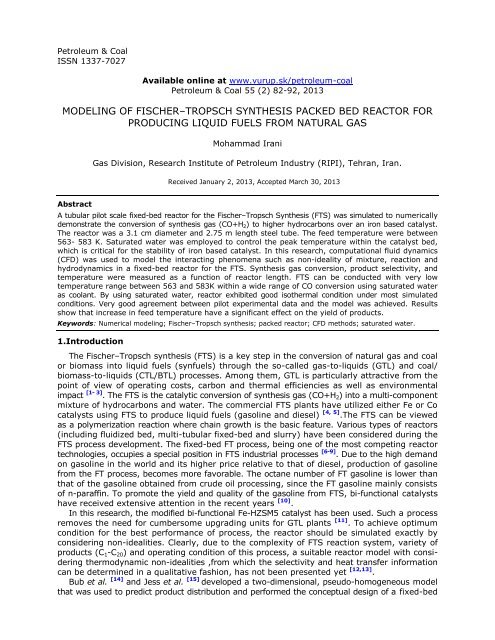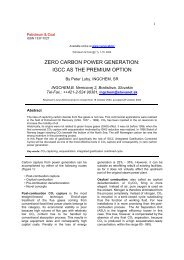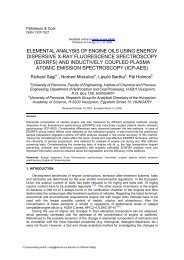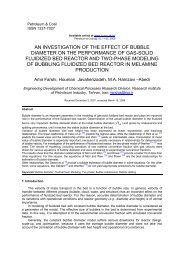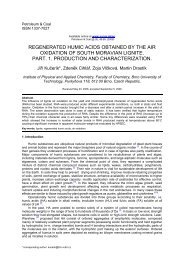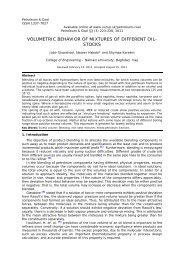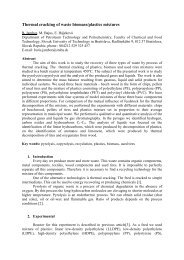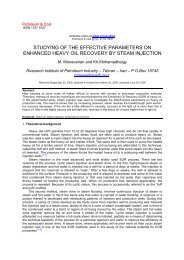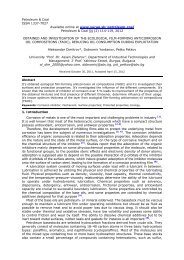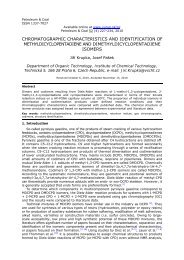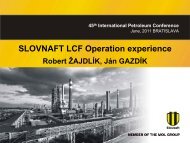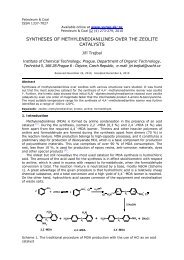FTS fixed-bed reactor based on Nano-structured Iron catalyst ...
FTS fixed-bed reactor based on Nano-structured Iron catalyst ...
FTS fixed-bed reactor based on Nano-structured Iron catalyst ...
Create successful ePaper yourself
Turn your PDF publications into a flip-book with our unique Google optimized e-Paper software.
Petroleum & CoalISSN 1337-7027Available <strong>on</strong>line at www.vurup.sk/petroleum-coalPetroleum & Coal 55 (2) 82-92, 2013MODELING OF FISCHER–TROPSCH SYNTHESIS PACKED BED REACTOR FORPRODUCING LIQUID FUELS FROM NATURAL GASMohammad IraniGas Divisi<strong>on</strong>, Research Institute of Petroleum Industry (RIPI), Tehran, Iran.Received January 2, 2013, Accepted March 30, 2013AbstractA tubular pilot scale <str<strong>on</strong>g>fixed</str<strong>on</strong>g>-<str<strong>on</strong>g>bed</str<strong>on</strong>g> <str<strong>on</strong>g>reactor</str<strong>on</strong>g> for the Fischer–Tropsch Synthesis (<str<strong>on</strong>g>FTS</str<strong>on</strong>g>) was simulated to numericallydem<strong>on</strong>strate the c<strong>on</strong>versi<strong>on</strong> of synthesis gas (CO+H 2 ) to higher hydrocarb<strong>on</strong>s over an ir<strong>on</strong> <str<strong>on</strong>g>based</str<strong>on</strong>g> <strong>catalyst</strong>.The <str<strong>on</strong>g>reactor</str<strong>on</strong>g> was a 3.1 cm diameter and 2.75 m length steel tube. The feed temperature were between563- 583 K. Saturated water was employed to c<strong>on</strong>trol the peak temperature within the <strong>catalyst</strong> <str<strong>on</strong>g>bed</str<strong>on</strong>g>,which is critical for the stability of ir<strong>on</strong> <str<strong>on</strong>g>based</str<strong>on</strong>g> <strong>catalyst</strong>. In this research, computati<strong>on</strong>al fluid dynamics(CFD) was used to model the interacting phenomena such as n<strong>on</strong>-ideality of mixture, reacti<strong>on</strong> andhydrodynamics in a <str<strong>on</strong>g>fixed</str<strong>on</strong>g>-<str<strong>on</strong>g>bed</str<strong>on</strong>g> <str<strong>on</strong>g>reactor</str<strong>on</strong>g> for the <str<strong>on</strong>g>FTS</str<strong>on</strong>g>. Synthesis gas c<strong>on</strong>versi<strong>on</strong>, product selectivity, andtemperature were measured as a functi<strong>on</strong> of <str<strong>on</strong>g>reactor</str<strong>on</strong>g> length. <str<strong>on</strong>g>FTS</str<strong>on</strong>g> can be c<strong>on</strong>ducted with very lowtemperature range between 563 and 583K within a wide range of CO c<strong>on</strong>versi<strong>on</strong> using saturated wateras coolant. By using saturated water, <str<strong>on</strong>g>reactor</str<strong>on</strong>g> exhibited good isothermal c<strong>on</strong>diti<strong>on</strong> under most simulatedc<strong>on</strong>diti<strong>on</strong>s. Very good agreement between pilot experimental data and the model was achieved. Resultsshow that increase in feed temperature have a significant effect <strong>on</strong> the yield of products.Keywords: Numerical modeling; Fischer–Tropsch synthesis; packed <str<strong>on</strong>g>reactor</str<strong>on</strong>g>; CFD methods; saturated water.1.Introducti<strong>on</strong>The Fischer–Tropsch synthesis (<str<strong>on</strong>g>FTS</str<strong>on</strong>g>) is a key step in the c<strong>on</strong>versi<strong>on</strong> of natural gas and coalor biomass into liquid fuels (synfuels) through the so-called gas-to-liquids (GTL) and coal/biomass-to-liquids (CTL/BTL) processes. Am<strong>on</strong>g them, GTL is particularly attractive from thepoint of view of operating costs, carb<strong>on</strong> and thermal efficiencies as well as envir<strong>on</strong>mentalimpact [1- 3] . The <str<strong>on</strong>g>FTS</str<strong>on</strong>g> is the catalytic c<strong>on</strong>versi<strong>on</strong> of synthesis gas (CO+H 2 ) into a multi-comp<strong>on</strong>entmixture of hydrocarb<strong>on</strong>s and water. The commercial <str<strong>on</strong>g>FTS</str<strong>on</strong>g> plants have utilized either Fe or Co<strong>catalyst</strong>s using <str<strong>on</strong>g>FTS</str<strong>on</strong>g> to produce liquid fuels (gasoline and diesel) [4, 5] .The <str<strong>on</strong>g>FTS</str<strong>on</strong>g> can be viewedas a polymerizati<strong>on</strong> reacti<strong>on</strong> where chain growth is the basic feature. Various types of <str<strong>on</strong>g>reactor</str<strong>on</strong>g>s(including fluidized <str<strong>on</strong>g>bed</str<strong>on</strong>g>, multi-tubular <str<strong>on</strong>g>fixed</str<strong>on</strong>g>-<str<strong>on</strong>g>bed</str<strong>on</strong>g> and slurry) have been c<strong>on</strong>sidered during the<str<strong>on</strong>g>FTS</str<strong>on</strong>g> process development. The <str<strong>on</strong>g>fixed</str<strong>on</strong>g>-<str<strong>on</strong>g>bed</str<strong>on</strong>g> FT process, being <strong>on</strong>e of the most competing <str<strong>on</strong>g>reactor</str<strong>on</strong>g>technologies, occupies a special positi<strong>on</strong> in <str<strong>on</strong>g>FTS</str<strong>on</strong>g> industrial processes [6-9] . Due to the high demand<strong>on</strong> gasoline in the world and its higher price relative to that of diesel, producti<strong>on</strong> of gasolinefrom the FT process, becomes more favorable. The octane number of FT gasoline is lower thanthat of the gasoline obtained from crude oil processing, since the FT gasoline mainly c<strong>on</strong>sistsof n-paraffin. To promote the yield and quality of the gasoline from <str<strong>on</strong>g>FTS</str<strong>on</strong>g>, bi-functi<strong>on</strong>al <strong>catalyst</strong>shave received extensive attenti<strong>on</strong> in the recent years [10] .In this research, the modified bi-functi<strong>on</strong>al Fe-HZSM5 <strong>catalyst</strong> has been used. Such a processremoves the need for cumbersome upgrading units for GTL plants [11] . To achieve optimumc<strong>on</strong>diti<strong>on</strong> for the best performance of process, the <str<strong>on</strong>g>reactor</str<strong>on</strong>g> should be simulated exactly byc<strong>on</strong>sidering n<strong>on</strong>-idealities. Clearly, due to the complexity of <str<strong>on</strong>g>FTS</str<strong>on</strong>g> reacti<strong>on</strong> system, variety ofproducts (C 1 -C 20 ) and operating c<strong>on</strong>diti<strong>on</strong> of this process, a suitable <str<strong>on</strong>g>reactor</str<strong>on</strong>g> model with c<strong>on</strong>sideringthermodynamic n<strong>on</strong>-idealities ,from which the selectivity and heat transfer informati<strong>on</strong>can be determined in a qualitative fashi<strong>on</strong>, has not been presented yet [12,13] .Bub et al. [14] and Jess et al. [15] developed a two-dimensi<strong>on</strong>al, pseudo-homogeneous modelthat was used to predict product distributi<strong>on</strong> and performed the c<strong>on</strong>ceptual design of a <str<strong>on</strong>g>fixed</str<strong>on</strong>g>-<str<strong>on</strong>g>bed</str<strong>on</strong>g>
eactor for c<strong>on</strong>verting nitrogen rich syngas. Atwood and Bennet [16] have proposed a <strong>on</strong>edimensi<strong>on</strong>al,homogeneous plug flow model. Wang et al. [17] devised a comprehensive <strong>on</strong>edimensi<strong>on</strong>alheterogeneous <str<strong>on</strong>g>reactor</str<strong>on</strong>g> model to simulate the performance of <str<strong>on</strong>g>fixed</str<strong>on</strong>g>-<str<strong>on</strong>g>bed</str<strong>on</strong>g> FT<str<strong>on</strong>g>reactor</str<strong>on</strong>g>s for hydrocarb<strong>on</strong> producti<strong>on</strong>. Liu et al. [18] have studied the steady state and dynamicbehavior of the FT <str<strong>on</strong>g>fixed</str<strong>on</strong>g>-<str<strong>on</strong>g>bed</str<strong>on</strong>g> <str<strong>on</strong>g>reactor</str<strong>on</strong>g> using a two-dimensi<strong>on</strong>al heterogeneous model. Also,Marvast et al. [19] have simulated the behavior of the FT <str<strong>on</strong>g>fixed</str<strong>on</strong>g>-<str<strong>on</strong>g>bed</str<strong>on</strong>g> <str<strong>on</strong>g>reactor</str<strong>on</strong>g> using a twodimensi<strong>on</strong>alheterogeneous model at steady state c<strong>on</strong>diti<strong>on</strong>.In the present work, we report a computati<strong>on</strong>al fluid dynamic (CFD) study to investigateperformance of a bi-functi<strong>on</strong>al Fe-HZSM-5 <strong>catalyst</strong> in a pilot scale tubular <str<strong>on</strong>g>fixed</str<strong>on</strong>g>-<str<strong>on</strong>g>bed</str<strong>on</strong>g> <str<strong>on</strong>g>reactor</str<strong>on</strong>g>for <str<strong>on</strong>g>FTS</str<strong>on</strong>g>, coupling the exothermic <str<strong>on</strong>g>FTS</str<strong>on</strong>g> with saturated water for heat removal. The CFD is apowerful tool for simulating complex reacting flows [20-24] . The aim of our study was to analyzethe c<strong>on</strong>diti<strong>on</strong>s under which the synthesis reacti<strong>on</strong> could be c<strong>on</strong>ducted at a reas<strong>on</strong>ably highCO c<strong>on</strong>versi<strong>on</strong> close to the isothermal c<strong>on</strong>diti<strong>on</strong> at temperatures between 563 and 583 K.The simulati<strong>on</strong> results have been validated with pilot experimental data.2. Process descripti<strong>on</strong>The <str<strong>on</strong>g>FTS</str<strong>on</strong>g> has been investigated in a pilot scale of a <str<strong>on</strong>g>fixed</str<strong>on</strong>g> <str<strong>on</strong>g>bed</str<strong>on</strong>g> <str<strong>on</strong>g>reactor</str<strong>on</strong>g> which was packed withbi-functi<strong>on</strong>al Fe-HZSM5 <strong>catalyst</strong> (metal part: 100 Fe/5.4 Cu/7K2O/21SiO2, acidic part:SiO2/Al 2 O 3 =14). There was a jacket around the <str<strong>on</strong>g>reactor</str<strong>on</strong>g> which boiling water flowing throughit to remove the heat of reacti<strong>on</strong>. The temperature of boiling water could be c<strong>on</strong>trolled measuringpressure of the system. The pilot has been designed and c<strong>on</strong>structed by the Research Instituteof Petroleum Industry, Nati<strong>on</strong>al Iranian Oil Company (RIPI-NIOC) in 2008 [12] . The characteristicsof the pilot plant are shown in Table 1. The object is to find the profiles of temperature andc<strong>on</strong>centrati<strong>on</strong> of various species al<strong>on</strong>g the <str<strong>on</strong>g>fixed</str<strong>on</strong>g>-<str<strong>on</strong>g>bed</str<strong>on</strong>g> <str<strong>on</strong>g>reactor</str<strong>on</strong>g> length at different c<strong>on</strong>diti<strong>on</strong>sand recognize the optimum c<strong>on</strong>diti<strong>on</strong>.Table1 <str<strong>on</strong>g>FTS</str<strong>on</strong>g> pilot plant characteristicsTube Dimensi<strong>on</strong>(mm) 31×3×2.75Number of tubes 1Molar Ratio of H2/Co 1Feed Temperature(K) 563,573 and 583Catalyst sizes (mm) 1.5×4Catalyst density(kg/m 3 ) 1290Bulk density(kg/m 3 ) 730Reactor pressure(bar) 17Cooling temperature (K) Saturated water (563,573 and 583)GHSV(Nl/hr) 3Bed Voidage 0.383. Mathematical Model3.1. Governing equati<strong>on</strong>sIn order to model the problem, five sets of equati<strong>on</strong>s should be solved; c<strong>on</strong>tinuity equati<strong>on</strong>,momentum balance, energy and species transport equati<strong>on</strong>s. The mass c<strong>on</strong>servati<strong>on</strong>,momentum, and total enthalpy equati<strong>on</strong>s, may be expressed as follows, respectively:.( v ) 0(1) .(v v) P.i Tvv g Sn (3).(v( H.( vCi– Di P)) .( C) Riii1h j ) .(q) SiM. Irani/Petroleum & Coal 55(2) 82-92, 2013 83R(2)(4)
22S DijvjC j1jij1 21 v v jSR jhMjjR j0 (5)Where, represents mixture density, v is velocity vector, and H, h i are total enthalpyand enthalpy of species, respectively and C i stands for c<strong>on</strong>centrati<strong>on</strong> of chemical species. Pis the static pressure, S is the model-dependent source term from porous-media and S R isthe heat of reacti<strong>on</strong> . The <strong>catalyst</strong> z<strong>on</strong>e c<strong>on</strong>sidered as a porous media that modeled by theadditi<strong>on</strong> of a momentum source term to the standard momentum equati<strong>on</strong>. The source termis composed of two parts: a viscous loss term (Darcy, the first term <strong>on</strong> the right-hand sideof Equati<strong>on</strong> 5) and an inertial loss term (the sec<strong>on</strong>d term <strong>on</strong> the right-hand side of Equati<strong>on</strong>5). v is the magnitude of the velocity and D and C are prescri<str<strong>on</strong>g>bed</str<strong>on</strong>g> matrices. The momentumsink c<strong>on</strong>tributes to the pressure gradient in the porous cells, causing a pressure drop that isproporti<strong>on</strong>al to the fluid velocity in the cells [25] .Due to complexity of the <str<strong>on</strong>g>FTS</str<strong>on</strong>g> reacti<strong>on</strong> system, variety of products (C 1 - C 20 ) and operatingc<strong>on</strong>diti<strong>on</strong> of the process, n<strong>on</strong>-ideal thermodynamic behavior of system should be c<strong>on</strong>sideredusing Eqs 6 to 8 [12,13] . Hereup<strong>on</strong>, a suitable EOS (equati<strong>on</strong> of state) should be used forcalculati<strong>on</strong> of mixture density and species fugacity (f i ). For this study Peng-Rabins<strong>on</strong> equati<strong>on</strong>was chosen as a suitable EOS which its parameters has been listed in table 2.Table 2 Parameters of Peng-Rabins<strong>on</strong> EOSσ ε Ω Ψ1 21 2(Tr;) 1 Z bPbeta RTf P y 20.37464 1.542260.26992 1 TZ Z1 Z q 0.07779 0.45724Pr, Tr12r2(Tr) , q Tbiln i ( Z 1) ln( Z beta ) I qibmaq bRT aqiq xibi[i] 2. - a (6)b1 Z 1 betaI ln() Z beta1i2ii2M. Irani/Petroleum & Coal 55(2) 82-92, 2013 84r3.2 Computati<strong>on</strong>al domain and boundary c<strong>on</strong>diti<strong>on</strong>sThe schematic of the setup is given in figure1, A two- dimensi<strong>on</strong>al system (2.75 m x 31mm)which was fed with synthesis gas (a mixture of carb<strong>on</strong> m<strong>on</strong>oxide and hydrogen). Furthermore,the <str<strong>on</strong>g>reactor</str<strong>on</strong>g> was divided in two secti<strong>on</strong>s:1) top z<strong>on</strong>e fluid, 2) reacti<strong>on</strong> (<strong>catalyst</strong>) z<strong>on</strong>e. Packed
M. Irani/Petroleum & Coal 55(2) 82-92, 2013 85<str<strong>on</strong>g>bed</str<strong>on</strong>g> was c<strong>on</strong>sidered as a porous media due to the large value of N (tube-to-<strong>catalyst</strong> diameterratio) [26] .Figure.1 Schematic of <str<strong>on</strong>g>fixed</str<strong>on</strong>g>-<str<strong>on</strong>g>bed</str<strong>on</strong>g> <str<strong>on</strong>g>reactor</str<strong>on</strong>g> and its boundary c<strong>on</strong>diti<strong>on</strong>sThe mass-flow-inlet boundary c<strong>on</strong>diti<strong>on</strong> was used for gas flow to the modeled <str<strong>on</strong>g>reactor</str<strong>on</strong>g>.The pressure-outlet boundary c<strong>on</strong>diti<strong>on</strong> was specified at the bottom of the <str<strong>on</strong>g>reactor</str<strong>on</strong>g>. The <str<strong>on</strong>g>FTS</str<strong>on</strong>g>reacti<strong>on</strong> is exothermic and if the heat of reacti<strong>on</strong> isn’t removed, temperature run away willbe taken place. In this study saturated water was used for heat removal, so heat absor<str<strong>on</strong>g>bed</str<strong>on</strong>g>by water generates steam and <str<strong>on</strong>g>reactor</str<strong>on</strong>g> was assumed to be isothermal. The source term (S)for boundary cells (walls in reacti<strong>on</strong> z<strong>on</strong>e) should be included as follows:S H ( T) H ( T)(7)Which H (T )of reacti<strong>on</strong>) and (T ) is enthalpy at temperature T (the increased temperature due to releasing heatH is enthalpy at temperature T (the desired temperature for reacti<strong>on</strong>).3.3. Products and rate equati<strong>on</strong>sWhen rate equati<strong>on</strong>s include in the CFD simulati<strong>on</strong>, chemical kinetic calculati<strong>on</strong>s are verycomputer time c<strong>on</strong>suming, especially for a complex reacti<strong>on</strong> scheme like <str<strong>on</strong>g>FTS</str<strong>on</strong>g> [17] . In somesimulati<strong>on</strong> studies the complexity of the <str<strong>on</strong>g>FTS</str<strong>on</strong>g> chemistry has been reduced by using a set ofglobal <strong>on</strong>e-step reacti<strong>on</strong> for selected mechanism [19] . The Fischer–Tropsch reactants andproducts which c<strong>on</strong>sidered in this study c<strong>on</strong>sist of: CO, H 2 , CO, CO 2 , H 2 O, CH4, C 2 H 4 , C 2 H 6 ,C 3 H 8 , n-C 4 H 10, i- C 4 H 10 and C 5 +. The following reacti<strong>on</strong>s listed in Table 3 are leading Fischer–Tropsch reacti<strong>on</strong>s [27] :Table 3 List of <str<strong>on</strong>g>FTS</str<strong>on</strong>g> reacti<strong>on</strong>sNum.Reacti<strong>on</strong> stoichiometry1 CO 3H2CH4 H2O2 2CO 4H2 C2H4 2H2O3 2 5HCH H OCO2 2 6224 3CO 7H2 C3H8 3H2O5 4CO 9H2 n C4H10 4H2O6 4CO 9H2 iC4H10 4H2O7 8.9618.05HCH ( C ) 8.H O8CO HCO2 8.96 12.36 59622OCO2 H2The general form of reacti<strong>on</strong> rate equati<strong>on</strong> is like Eq. (8) and for <str<strong>on</strong>g>FTS</str<strong>on</strong>g> its kinetic parameters [27]are given in table 4:Rmoli hr.grcat E fi kiexp RT f2h2co(8)
Table 4 <str<strong>on</strong>g>FTS</str<strong>on</strong>g> parameters of reacti<strong>on</strong> ratesK 1 (mol s -1 kg -1 cat /kPa) E 1 (J mol -1 )1 2.044 e-2 156932 6.255 e-5 20.3843 3.423 e-4 1.56074 5.972 e-6 164.065 6.482 e-6 86.9346 6.482 e-6 81.7537 3.168 e-5 738.788 3.168 e-5 5532.93.4. Material propertiesThe specific heat of each species was defined as piecewise-polynomial functi<strong>on</strong> of temperature.Besides to c<strong>on</strong>sider variati<strong>on</strong> of density with temperature and compositi<strong>on</strong>, compressibilityfactor (Z) was calculated using Peng-Rabins<strong>on</strong> EOS and also the density of gas mixture wasdefined as follow:P M Z RTWhere R is the universal gas c<strong>on</strong>stant, M G is the molecular weight of gas mixture and P isthe operating pressure (taken to be 17 bar). For other thermal properties of the mixture suchas molecular viscosity, thermal c<strong>on</strong>ductivity and diffusivity coefficient, the relati<strong>on</strong>s in appendixwere used [28].The steps implemented in the soluti<strong>on</strong> procedure are as follows:1. Calculati<strong>on</strong> of the gas-phase transport properties.2. Calculati<strong>on</strong> of the density of gas mixture using Peng-Rabins<strong>on</strong> EOS.3. Calculati<strong>on</strong> of the thermodynamic properties such as fugacity coefficients andcompressibility factors using special subroutines.4. Determinati<strong>on</strong> of the rate of c<strong>on</strong>sumpti<strong>on</strong> of reactants and producti<strong>on</strong> of products per unitvolume.5. Determinati<strong>on</strong> of the source terms for all the c<strong>on</strong>servati<strong>on</strong> equati<strong>on</strong>s.6. Solving the c<strong>on</strong>servati<strong>on</strong> equati<strong>on</strong>s.The finite volume method has been used to discrete the partial differential equati<strong>on</strong>s ofthe model, using the SIMPLE method for pressure–velocity coupling.4. RESULTS AND DISCUSSIONM. Irani/Petroleum & Coal 55(2) 82-92, 2013 86The geometry and grid was created in Gambit (Figure 2), the pre-processor of Fluent. Thegeometry c<strong>on</strong>sists of a rectangle, 2.75m in length and 31mm in width, with uniform <strong>structured</strong>grids to simulate fluid flow. A parametric study was d<strong>on</strong>e by varying the gas inlet temperature.In all cases, <str<strong>on</strong>g>reactor</str<strong>on</strong>g> pressure and H 2 /CO ratio are kept c<strong>on</strong>stant at 17 bar and 1, respectively.Based <strong>on</strong> the variati<strong>on</strong> of gas inlet temperatures, three set of simulati<strong>on</strong>s were performed.(9)Figure 2 Mesh c<strong>on</strong>figurati<strong>on</strong> of computati<strong>on</strong>al domainFigure 3 presents the c<strong>on</strong>tour of velocity in the <str<strong>on</strong>g>reactor</str<strong>on</strong>g>. As can be seen, in the first z<strong>on</strong>eof the <str<strong>on</strong>g>reactor</str<strong>on</strong>g> the velocity has the maximum value and in <strong>catalyst</strong> regi<strong>on</strong>, it is decreased dueto the pressure drop in the reacti<strong>on</strong> z<strong>on</strong>e.Figure 4 shows the mass fracti<strong>on</strong> profiles of product species al<strong>on</strong>g the <str<strong>on</strong>g>reactor</str<strong>on</strong>g> length forthe case with the inlet gas temperature of 573 K. As shown in figure 4 the mass fracti<strong>on</strong> ofproduct species is c<strong>on</strong>tinuously increasing from the inlet to the outlet and there is a jump in
Mass Fracti<strong>on</strong>M. Irani/Petroleum & Coal 55(2) 82-92, 2013 87the end z<strong>on</strong>e of the <str<strong>on</strong>g>reactor</str<strong>on</strong>g> due to the decrease in mass fracti<strong>on</strong> of CO. (c<strong>on</strong>sidering reacti<strong>on</strong>rates, denominator is fugacity of CO).Figure.3 C<strong>on</strong>tour of velocity (operating c<strong>on</strong>diti<strong>on</strong>: T=573, P=17 bar)0.140.120.10.08methaneetilenpropaanEthaneButhaneC5+CO0.060.040.0200 0.25 0.5 0.75 1 1.25 1.5 1.75 2 2.25 2.5 2.75Reactor length(m)Figure. 4. Mass fracti<strong>on</strong> of species al<strong>on</strong>g the <str<strong>on</strong>g>reactor</str<strong>on</strong>g> length at T=573As depicted in figure 5 in the case with temperature of 563 the C 5+ selectivity was lessthan the case with temperature of 573. When the temperature was increased to 583K, C 5+selectivity was declined because of activati<strong>on</strong> of water-gas-shift reacti<strong>on</strong> at this temperatureand increasing of CO 2 producti<strong>on</strong>.Based <strong>on</strong> the producti<strong>on</strong> of heavier products in reacti<strong>on</strong> z<strong>on</strong>e, density increases al<strong>on</strong>g the<str<strong>on</strong>g>reactor</str<strong>on</strong>g> length (Figure 7).
SelectivityM. Irani/Petroleum & Coal 55(2) 82-92, 2013 882015T=563 K10T=573 KT=583 K500 0.5 1 1.5 2 2.5Reactor length (m)Figure. 5. Selectivity of species at different temperatures al<strong>on</strong>g the <str<strong>on</strong>g>reactor</str<strong>on</strong>g> length4.1. C<strong>on</strong>trol of the <str<strong>on</strong>g>FTS</str<strong>on</strong>g> temperatureAs menti<strong>on</strong>ed before, the aim of this study was to analyze the c<strong>on</strong>diti<strong>on</strong>s that the <str<strong>on</strong>g>FTS</str<strong>on</strong>g>could be c<strong>on</strong>ducted in a <str<strong>on</strong>g>fixed</str<strong>on</strong>g>-<str<strong>on</strong>g>bed</str<strong>on</strong>g> <str<strong>on</strong>g>reactor</str<strong>on</strong>g> at a reas<strong>on</strong>ably high CO c<strong>on</strong>versi<strong>on</strong> near isothermalc<strong>on</strong>diti<strong>on</strong> at any desired reacti<strong>on</strong> temperature between 563 and 583 K. To this end, a seriesof CFD simulati<strong>on</strong>s have been carried out in which the significant result of this simulati<strong>on</strong>study has been c<strong>on</strong>firmati<strong>on</strong> of the isothermicity exhibiti<strong>on</strong> of the <str<strong>on</strong>g>fixed</str<strong>on</strong>g>-<str<strong>on</strong>g>bed</str<strong>on</strong>g> <str<strong>on</strong>g>reactor</str<strong>on</strong>g>. As anexample, figure 6 shows the distributi<strong>on</strong> of temperatures al<strong>on</strong>g the <str<strong>on</strong>g>reactor</str<strong>on</strong>g> length at steadystate c<strong>on</strong>diti<strong>on</strong> for a simulati<strong>on</strong> c<strong>on</strong>ducted under c<strong>on</strong>diti<strong>on</strong>s of T=573 K, P=17 bar.Figure.6 C<strong>on</strong>tour of temperature (operating c<strong>on</strong>diti<strong>on</strong>: T=573, P=17 bar)As shown in this figure, temperature profiles of two cases were presented. In case 1 heatremoval was d<strong>on</strong>e with saturated water and in case 2 without heat removal. As can be seen,the maximum difference of temperature inside the <str<strong>on</strong>g>fixed</str<strong>on</strong>g>-<str<strong>on</strong>g>bed</str<strong>on</strong>g> <str<strong>on</strong>g>reactor</str<strong>on</strong>g> is lower than 14K, andthe mean temperature of the solid is about 575 K, close to the coolant. Interestingly, the tempe-
M. Irani/Petroleum & Coal 55(2) 82-92, 2013 89rature of the fluid inside the <strong>catalyst</strong> z<strong>on</strong>e, where the reacti<strong>on</strong> takes place, is almost c<strong>on</strong>stant atabout 577 K, that is well-suited. If there isn’t any heat removal in <str<strong>on</strong>g>reactor</str<strong>on</strong>g>, the temperatureat the fr<strong>on</strong>t of catalytic <str<strong>on</strong>g>bed</str<strong>on</strong>g> is increased to 685 K and the average temperature of the fluid incatalytic <str<strong>on</strong>g>bed</str<strong>on</strong>g> will remain <strong>on</strong> 650 K. This temperature is not suitable for <strong>catalyst</strong> performanceand <strong>catalyst</strong> degradati<strong>on</strong> will occurred. These results presage a very efficient heat exchangeperformance of the saturated water. It should be noted that the saturated water temperaturecan be c<strong>on</strong>trolled with pressure. The maximum change in temperature of the <str<strong>on</strong>g>FTS</str<strong>on</strong>g> stream insidethe <str<strong>on</strong>g>reactor</str<strong>on</strong>g> from the entry to the exit is about 10–15 K (Figure 7). Therefore, almost isothermal<str<strong>on</strong>g>FTS</str<strong>on</strong>g> can be achieved by setting the operating pressure at a value which the saturati<strong>on</strong> temperatureof liquid water is slightly below the temperature of the FT synthesis. The pressure ofboiling water system has to be reduced when the CO c<strong>on</strong>versi<strong>on</strong> increases, to have efficientheat-removal capacity.Figure.7 Profile of density (operating c<strong>on</strong>diti<strong>on</strong>: T=573, P=17 bar)4.2. Quantitative validati<strong>on</strong>Despite the fact that the results shown in figures 3 to 8 were used for qualitative validati<strong>on</strong>of the model and the soluti<strong>on</strong> procedure, in order to ensure the accuracy of the model, quantitativecomparis<strong>on</strong> of experimental data obtained from pilot and their corresp<strong>on</strong>ding simulated resultsis shown in table 5. Since it was limited to use the finite number of thermocouples, (point 1:beginning of catalytic <str<strong>on</strong>g>bed</str<strong>on</strong>g>; point 2: middle of catalytic <str<strong>on</strong>g>bed</str<strong>on</strong>g>; point 3: end of catalytic <str<strong>on</strong>g>bed</str<strong>on</strong>g>) <strong>on</strong>lythree experimental data of temperatures have been obtained and compared against theircorresp<strong>on</strong>ding simulated results. As this table shows, the errors at all times are less than fivepercent, since simulati<strong>on</strong> is <str<strong>on</strong>g>based</str<strong>on</strong>g> <strong>on</strong> the CFD approach and no empirical correlati<strong>on</strong> has beenused in the simulati<strong>on</strong>.Table 5 Comparis<strong>on</strong> between measured and predicted values for the pilot-scale <str<strong>on</strong>g>FTS</str<strong>on</strong>g>processesexperimental simulati<strong>on</strong> Error (%)X CO (%) 60.7 58.59 3.476112C5+ selectivity (g/g feed) 18 17.29 3.944444Temperature at point 1(K) 588 590 0.340140Temperature at point 2(K) 575 573 0.347826Temperature at point 3(K) 573 573 05. C<strong>on</strong>clusi<strong>on</strong>sThe detailed kinetics is em<str<strong>on</strong>g>bed</str<strong>on</strong>g>ded into the <str<strong>on</strong>g>reactor</str<strong>on</strong>g> model .The n<strong>on</strong>-ideal thermodynamicbehavior of mixture is correlated by using Peng-Rabins<strong>on</strong> EOS. The <str<strong>on</strong>g>reactor</str<strong>on</strong>g> model is tested
against the measured data from pilot-scale and satisfactory agreements are found betweenpredicti<strong>on</strong>s of model and experimental results. The numerical investigati<strong>on</strong> reveals that theproposed model can allow us to gain a quantitative insight into the complicated <str<strong>on</strong>g>fixed</str<strong>on</strong>g>-<str<strong>on</strong>g>bed</str<strong>on</strong>g><str<strong>on</strong>g>FTS</str<strong>on</strong>g> system. From the simulati<strong>on</strong> data presented in this paper, a <str<strong>on</strong>g>reactor</str<strong>on</strong>g> optimizati<strong>on</strong> strategycan be deduced; operating at the highest possible c<strong>on</strong>versi<strong>on</strong> to achieve the maximum C 5+yield while minimizing temperature run away. The simulated <str<strong>on</strong>g>reactor</str<strong>on</strong>g> exhibited good isothermicityunder most simulated c<strong>on</strong>diti<strong>on</strong>s by using saturated water as heat removing system.Increasing of feed temperature can increase syngas c<strong>on</strong>versi<strong>on</strong>; however it suppressesremarkably the overall yield of C 5+ products. Therefore the selecti<strong>on</strong> of feed temperature isimportant <strong>on</strong> the premier of keeping a satisfied syngas c<strong>on</strong>versi<strong>on</strong> for enhancement of theoverall yield of C 5+ products.NomenclatureM. Irani/Petroleum & Coal 55(2) 82-92, 2013 90P Pressure, bar T Temperature, Kg gravity accelerati<strong>on</strong>, m.s -2 f fugacity, barv velocity, m.s -1 k i Kinetic C<strong>on</strong>stant, mol.hr -1 .gr -1 .bar -1H Total enthalpy, kJ.kg -1 .s -1 E i Activati<strong>on</strong> Energy, kJ.kmol -1h Enthalpy of species, kJ.kg -1 .s -1 R Global Gas Factor, kJ.kmol -1 .K -1j Mass flux, kg.m -2 .s -1 M i Molecular Weight, kg.kmol -1q Heat flux, kJ.m -2 .s -1 V Volume, m 3S Momentum source term, x i mass fracti<strong>on</strong>D ij Diffusivity coefficient, D Total Diffusivity Coefficient, m 2 .s -1C i C<strong>on</strong>centrati<strong>on</strong>, kmol.m 3 k m Thermal C<strong>on</strong>ductivity, kJ.m -1 .K -1Z Compressibility FactorGreek LettersSubscriptρ Density, kg.m -3 i species numberμ Viscosity, kg.m -1 .s -1 j sec<strong>on</strong>d species numberφ i Fugasity coefficient m mixtureReferences[1] Bartholomew, C.H., Farrauto, R. J.: Fundamentals of Industrial Catalytic Processes,New Jersey: John Wiley & S<strong>on</strong>s Inc. – AIChE, Hoboken, 2006, 398.[2] Dry, M.E., Steynberg, P.: Studies in Surface Science and Catalysis, 2004, 152:406.[3] Davis, B.H.: Fischer−Tropsch Synthesis: Comparis<strong>on</strong> of Performances of Ir<strong>on</strong> andCobalt Catalysts, Ind. Eng. Chem. Res., 2007, 46 (26), pp 8938–8945.[4] Reidel, T., Schulz, H., Schaub, G., Jun, K., Hwang, J., Lee, K.: Topics in Catalysis,2003, 26:41.[5] De Deugd, R.M., Kapteijn, F., Moulijn, J. A.: Topics in Catalysis, 2003, 26:29.[6] Steynberg, A.P., Dry, M. E., Havis, B.H., Berman, B. B.: Studies in Surface Scienceand Catalysis, 2004, 152:64.[7] Dry, M.E.: Practical and Theoretical Aspects of the Catalytic Fischer-Tropsch Process,Applied Catalysis A: General, 1996, 138:319.[8] Sie, S.T. : Process development and scale up: IV Case history of the development ofa Fischer-Tropsch synthesis process, Rev. Chem. Eng. 1998, 14, 109–157.[9] Davis, B.H.: Topics in Catalysis, 2005, 32:143.[10] Nakhaei Pour, Zamani, Y., Tavasoli, A., Shahri, S.M. K., Taheri , S.A.: Study <strong>on</strong>products distributi<strong>on</strong> of ir<strong>on</strong> and ir<strong>on</strong>–zeolite <strong>catalyst</strong>s in Fischer–Tropsch synthesis ,Fuel, 2008, 87:2004.[11] Fischer–Tropsch pilot plant of Research Institute of Petroleum Industry and Nati<strong>on</strong>alIranian Oil Company (RIPI-NIOC), Tehran 18745-4163, Iran, 2004.[12] Irani, M., Bozorgmehry, R.B., Pishvaie, M. R., Tavasoli, A.: Investigating the effectsof mass transfer and mixture n<strong>on</strong>-ideality <strong>on</strong> multiphase flow hydrodynamics usingCFD methods, Iran. J. Chem. and Chem. Eng., 2009.
[13] Irani, M., Bozorgmehry, R.B., Pishvaie, M. R.,: Impact of Thermodynamic N<strong>on</strong>idealitiesand Mass Transfer <strong>on</strong> Multi-phase Hydrodynamics,Sci. Iranica, 2010.[14] Bub, G., Bearns, M., Bussemier, B., Frohning, C.: Chemical Engineering Science,2003, 58:867.[15] Jess, A., Popp, R., Hedden, K.: Fischer-Trospch synthesis with nitrogen- rich syngas:Fundamentals and <str<strong>on</strong>g>reactor</str<strong>on</strong>g> design aspects, Applied Catalysis A, 1999, 186:321.[16] Atwood, H.E., Bennet, C.O.: Ind. Eng. Chem. Proc. Des. Dev.1979, 18:163.[17] Wang, Y.N., Xu, Y.Y., Li, Y.W., Zhao, Y.L., Zhang, B.J.: Chem. Eng. Sci., 2003,58:867.[18] Liu, Q. S., Zhang, Z.X., Zhou, J. L.: J.Nat.Gas Chem. 1999, 8:137.[19] Marvast, M.A., Sohrabi, M., Zarrinpashneh, S., Baghmisheh ,Gh.: Chem. Eng. andTech., 2005, 1:28.[20] Amirshaghaghi, H., Zamaniyan, A., Ebrahimi, H., Zarkesh, M.: Numerical simulati<strong>on</strong>of methane partial oxidati<strong>on</strong> in the burner and combusti<strong>on</strong> chamber of autothermalreformer, Applied Mathematical Modelling,34(2010) 2312-2322.[21] Jazbec, M., Fletcher, D. F., Haynes, B. S.: Simulati<strong>on</strong> of the igniti<strong>on</strong> of lean methanemixtures using CFD modelling and a reduced chemistry mechanism, AppliedMathematical Modeling, 24, 8-9(2000) 689-696.[22] Pougatch, K., Salcudean, Gartshore,M. I.: A numerical model of the reactingmultiphase flow in a pulp digester, Applied Mathematical Modeling, 30 (2006) 209–230.[23] Shang, Z.: CFD of turbulent transport of particles behind a backward-facing stepusing a new model—k-e-Sp, Applied Mathematical Modeling, 29 (2005) 885–901.[24] Gerber, A.G., Dubay, R., Healy, A.: CFD-<str<strong>on</strong>g>based</str<strong>on</strong>g> predictive c<strong>on</strong>trol of melt temperaturein plastic injecti<strong>on</strong> molding, Applied Mathematical Modeling 30 (2006) 884–903.[25] Fluent, Incorporated: FLUENT 6 USER Manual, Leban<strong>on</strong> (NH): Fluent Inc., 2001.[26] Foumeni, E.A., Moallemi, H.A., Mcgreavy, C., Castro, A.A.: Canad. J. Chem. Eng.,1991, 69:1010.[27] Marvast, M.A.: Ph.D. Thesis, Amirkabir University of Technology: Tehran- Iran, 2005.[28] Poling, B.E., Prausnitz, J. M., O’C<strong>on</strong>nell, J.P.: The Properties of Gases & Liquids, 5 thed., New York: McGraw-Hill, 2000.[29] Mas<strong>on</strong>, E.A., Saxena, S.C.: Phys. Fluids, (1958) 1:361.Corresp<strong>on</strong>ding author, PhD of Chemical Engineering. postal address: Gas Divisi<strong>on</strong>, ResearchInstitute of Petroleum Industry (RIPI), West Blvd., Near Azadi Sports Complex, Tehran, Iran.Ph<strong>on</strong>e: +98 (21) 48252403, Fax: +98 (21) 44739716, E-mail address: Iranim@ripi.ir orMohammadirani@yahoo.comAppendixThermophysical properties in the gas phase were calculated using the following relati<strong>on</strong>s [28].Binary DiffusivityFuller’s method was used to determine diffusivity:AndDDM M/ M M1.75 1 2 1 2 0.04357 T(A.1)1 13 3 2P(V1V2)(1 xixjDi, m ) nj1ij(A.2)Where V i is found for each comp<strong>on</strong>ent by summing atomic diffusi<strong>on</strong> volumes given in [28] .Gas-Phase Mixture ViscosityM. Irani/Petroleum & Coal 55(2) 82-92, 2013 91Wilke’s method has been used to determine the gas-phase viscosity. It is expressed as
nmx (A.3)x WhereAndiji ni1j 10.5 M1i j M81i MjijjjMi 0.50.25 2 (A.4)ji (A.5)j Mi ijiMjGas-Phase Mixture Thermal C<strong>on</strong>ductivityThermal c<strong>on</strong>ductivity of the gas mixture was determined as follows. However, anadditi<strong>on</strong>al factor proposed by Mas<strong>on</strong> and Saxena [29] was used:kmWhereAndn ni1j 1x kixjiAij k Mj 1i k jM i Aij0.5 M 81i M j 1.065AM0.5 0.252(A.6)(A.7)j iji Aij(A.8)iMjSpecific heatCmPni1x CiiPM. Irani/Petroleum & Coal 55(2) 82-92, 2013 92(A.9)


